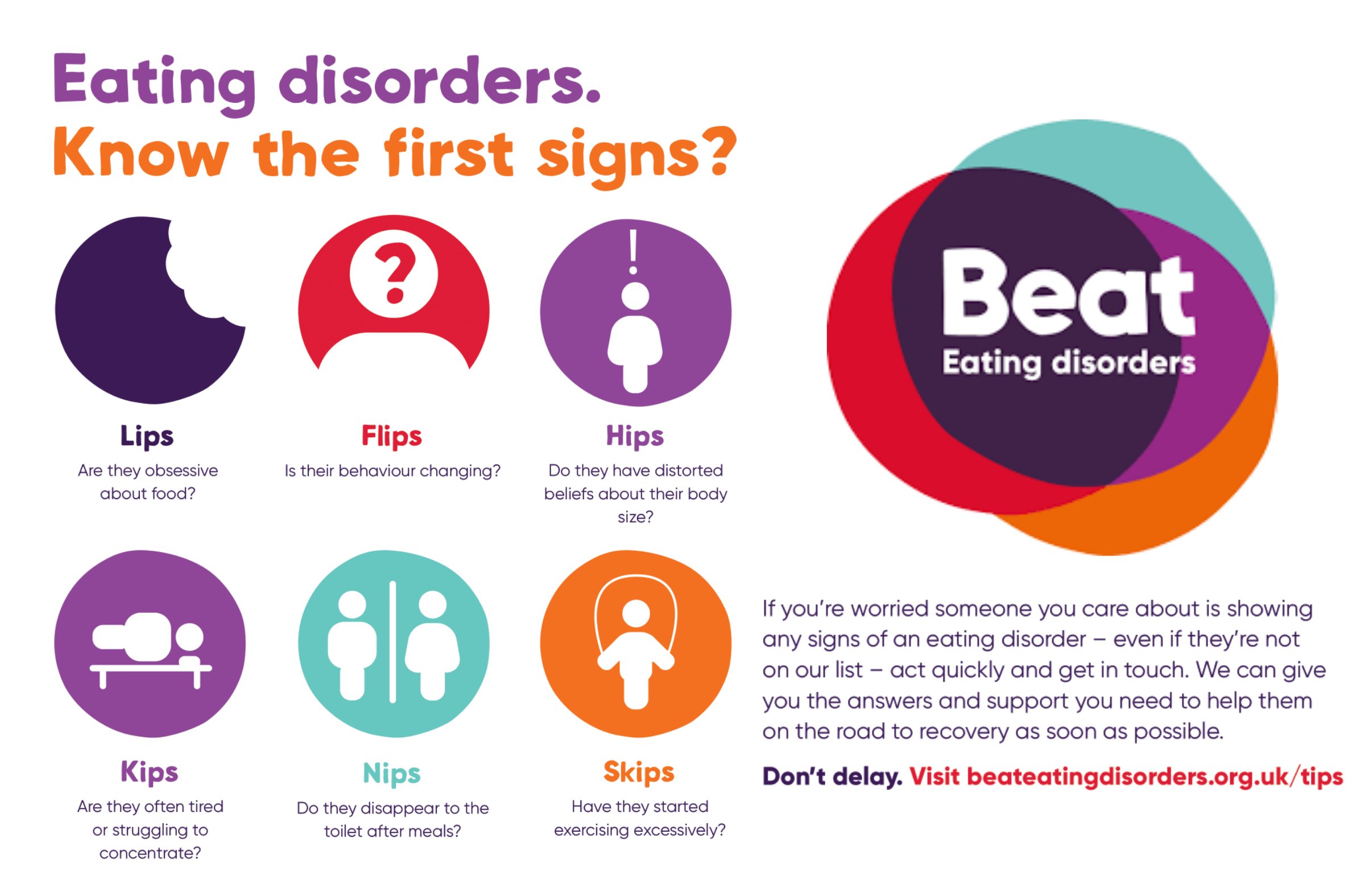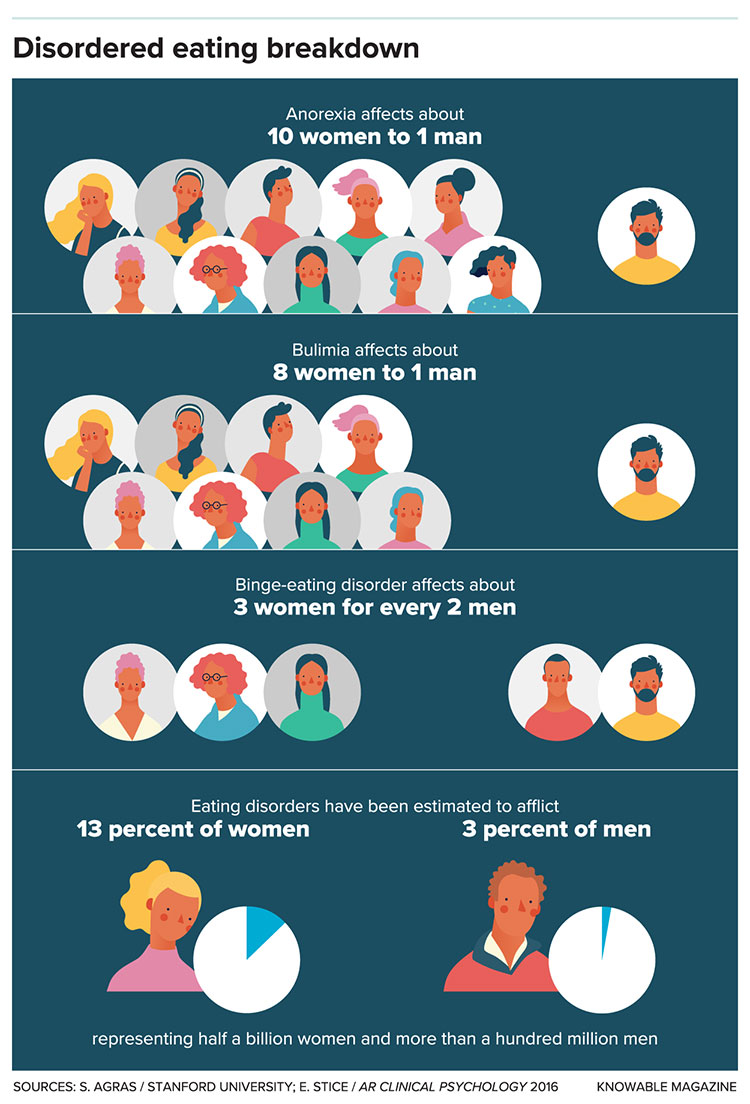Introduction
Eating disorders are serious psychiatric conditions characterized by abnormal eating behaviors, disturbed body image, and maladaptive attitudes toward food, weight, and shape. They are associated with high morbidity and mortality, often involving medical complications, psychiatric comorbidity, and impaired quality of life. The DSM-5 (APA, 2013) recognizes a spectrum of eating disorders, including Pica, Rumination Disorder, Anorexia Nervosa (AN), Bulimia Nervosa (BN), and Binge-Eating Disorder (BED).

Eating Disorder
While Pica and Rumination Disorder are more common in children and individuals with developmental disabilities, Anorexia Nervosa, Bulimia Nervosa, and Binge-Eating Disorder are adolescent- and adult-onset disorders with significant psychosocial and biological underpinnings (Butcher, Mineka, & Hooley, 2014).
Read More: DSM vs ICD
Classification and Diagnostic Criteria
1. Pica
Persistent eating of non-nutritive, non-food substances (e.g., clay, paper, soap, hair, ice, chalk) for at least one month (APA, 2013).
Diagnostic Features:
- Behavior is inappropriate to developmental stage.
- Not culturally sanctioned.
- May occur in children, pregnant women, or individuals with intellectual disability.
Complications: Lead poisoning, intestinal blockages, infections (Comer, 2007).
2. Rumination Disorder
Repeated regurgitation of food, which may be rechewed, reswallowed, or spit out, occurring for at least one month (APA, 2013).
Diagnostic Features:
- Not due to gastrointestinal or medical conditions.
- Not better explained by eating disorders like AN or BN.
- Common in infants and children, but can persist into adulthood (Davison, Neal, & Kring, 2004).
Complications: Malnutrition, weight loss, social impairment.
3. Anorexia Nervosa (AN)
Restriction of food intake leading to significantly low body weight, accompanied by intense fear of weight gain and disturbance in body image.
DSM-5 Subtypes:
- Restricting Type: Weight loss through dieting, fasting, or excessive exercise.
- Binge-Eating/Purging Type: Involves binge eating or purging behaviors (self-induced vomiting, laxatives, diuretics).
Complications: Severe malnutrition, amenorrhea, osteoporosis, cardiac arrhythmias, high mortality risk (Nevid, Rathus, & Greene, 2014).
4. Bulimia Nervosa (BN)
Recurrent binge eating episodes followed by inappropriate compensatory behaviors (vomiting, laxatives, fasting, excessive exercise) to prevent weight gain.
Diagnostic Features (APA, 2013):
- Binges involve consuming an objectively large amount of food within a discrete period.
- Occurs at least once a week for three months.
- Self-evaluation is unduly influenced by body shape and weight.
Complications: Electrolyte imbalance, gastrointestinal problems, dental erosion, cardiac risk (Butcher et al., 2014).
5. Binge-Eating Disorder (BED)
Recurrent binge eating without compensatory behaviors.
Diagnostic Features:
- Eating rapidly, until uncomfortably full, or when not hungry.
- Associated with guilt, shame, and distress.
- Occurs at least once per week for three months (APA, 2013).
Complications: Obesity, diabetes, hypertension, cardiovascular disease (Carson et al., 2007).

Eating Disorder
Etiological Factors
Eating disorders are multifactorial in origin, involving biological, psychological, and sociocultural influences.
1. Biological Factors
- Genetic Vulnerability: Twin and family studies show heritability of 40–60% for AN and BN (Butcher et al., 2014).
- Neurobiological Abnormalities: Dysregulation of serotonin and dopamine pathways affects appetite and reward sensitivity (Nolen-Hoeksema, 2004).
- Hormonal Influences: Dysregulation of leptin, ghrelin, and hypothalamic-pituitary-adrenal (HPA) axis contributes to disordered eating behaviors.
2. Psychological Factors
- Cognitive Distortions: Overvaluation of weight, shape, and control over eating (Nevid et al., 2014).
- Personality Traits: Perfectionism, obsessionality, impulsivity, and low self-esteem predispose individuals to AN and BN (Davison et al., 2004).
- Emotional Regulation: Binge eating and purging may serve as maladaptive coping strategies for negative emotions (Sue, Sue, & Sue, 2006).

Eating Disorder and Cognition
3. Social and Cultural Factors
- Sociocultural Pressures: Thin-ideal internalization, media influence, and peer comparison contribute to body dissatisfaction (Sarason & Sarason, 2002).
- Family Environment: Enmeshment, overprotectiveness, and high parental expectations are linked to AN, whereas chaotic or neglectful families correlate with BN and BED (Comer, 2007).
- Cultural Variability: Eating disorders are more prevalent in Western societies, but globalization has increased incidence in non-Western contexts (WHO, 1992).
Treatment Approaches
Some of the approaches to treatment includes:
1. Pica and Rumination Disorder
- Behavioral Interventions: Positive reinforcement, aversion therapy, and habit-reversal training (Andrew, 2011).
- Nutritional Support: Correcting deficiencies such as iron or zinc (Puri, Laking, & Treasaden, 1996).
- Parental Education: In children, modifying environmental triggers and providing consistent caregiving.
2. Anorexia Nervosa
- Medical Stabilization: Hospitalization for severe malnutrition, electrolyte imbalance, or cardiac risk.
- Psychotherapy:
- Family-Based Therapy (Maudsley Approach): Particularly effective for adolescents; parents take an active role in refeeding (Butcher et al., 2014).
- Cognitive-Behavioral Therapy (CBT): Targets cognitive distortions about body image and food.
- Pharmacotherapy: Limited effectiveness; antidepressants may help with comorbid depression but not core AN symptoms (Carson et al., 2007).
3. Bulimia Nervosa
- CBT (Gold Standard): Reduces binge-purge cycles and modifies dysfunctional attitudes toward eating and weight (Barlow & Durand, 2005).
- Interpersonal Therapy (IPT): Addresses interpersonal deficits contributing to disordered eating.
- Pharmacological Treatment: SSRIs (fluoxetine) are FDA-approved and reduce binge-purge episodes (Nolen-Hoeksema, 2004).
4. Binge-Eating Disorder
- CBT & Self-Help Programs: Effective in reducing binge frequency and associated distress (Nevid et al., 2014).
- Behavioral Weight Loss Therapy: Addresses obesity-related consequences.
- Pharmacological Interventions: Lisdexamfetamine dimesylate (FDA-approved) reduces binge frequency; SSRIs may also help (Butcher et al., 2014).
Prognosis and Challenges
- Anorexia Nervosa: Chronic and difficult to treat, with the highest mortality rate among psychiatric disorders (10–15%) (APA, 2013).
- Bulimia Nervosa: Better prognosis than AN, but relapse is common without ongoing therapy (Davison et al., 2004).
- Binge-Eating Disorder: Often remits with treatment, but obesity-related medical complications persist (Carson et al., 2007).
- Pica and Rumination Disorder: Often resolve in children but can persist if associated with developmental disabilities.
Barriers to treatment include stigma, denial of illness, and lack of specialized services. Cultural variations also affect recognition and willingness to seek care (Sue et al., 2006).
Conclusion
Eating disorders—including Pica, Rumination Disorder, Anorexia Nervosa, Bulimia Nervosa, and Binge-Eating Disorder—represent a diverse but interconnected set of conditions characterized by disturbed eating patterns and maladaptive beliefs about food and body image. Their etiology is multifactorial, involving genetics, neurobiology, personality, and sociocultural pressures.
Effective treatment requires multimodal, individualized approaches: medical stabilization, psychotherapy (particularly CBT and family-based therapy), pharmacological support, and cultural sensitivity. Early intervention is crucial, particularly for Anorexia Nervosa, which carries high mortality. Addressing stigma, increasing awareness, and expanding specialized treatment centers remain global priorities for reducing the burden of eating disorders.
References
American Psychiatric Association. (2013). Diagnostic and Statistical Manual of Mental Disorders (5th ed.). Arlington, VA: APA.
Andrew, M. (2011). Clinical psychology: Science, practice, and culture (2nd ed.). Sage Publications.
Alloy, L. B., Riskind, J. H., & Manos, M. J. (2005). Abnormal Psychology: Current Perspectives (9th ed.). Tata McGraw-Hill.
Barlow, D. H., & Durand, V. M. (2005). Abnormal Psychology (4th ed.). Pacific Grove: Brooks/Cole.
Butcher, J. N., Mineka, S., & Hooley, J. M. (2014). Abnormal Psychology (15th ed.). Pearson Education.
Carson, R. C., Butcher, J. N., Mineka, S., & Hooley, J. M. (2007). Abnormal Psychology (13th ed.). Pearson.
Comer, R. J. (2007). Abnormal Psychology (6th ed.). Worth Publishers.
Davison, G. C., Neal, J. M., & Kring, A. M. (2004). Abnormal Psychology (9th ed.). Wiley.
Nevid, J. S., Rathus, S. A., & Greene, B. (2014). Abnormal Psychology (9th ed.). Pearson Education.
Nolen-Hoeksema, S. (2004). Abnormal Psychology (3rd ed.). McGraw Hill.
Oltmanns, T. F., & Emery, R. E. (1995). Abnormal Psychology. Prentice Hall.
Puri, B. K., Laking, P. J., & Treasaden, I. H. (1996). Textbook of Psychiatry. Churchill Livingston.
Sarason, I. G., & Sarason, R. B. (2002). Abnormal Psychology: The Problem of Maladaptive Behavior (10th ed.). Pearson Education.
Sue, D., Sue, D. W., & Sue, S. (2006). Abnormal Behavior (8th ed.). Houghton Mifflin.
World Health Organization. (1992). The ICD-10 Classification of Mental and Behavioural Disorders: Clinical Description and Diagnostic Guidelines. Oxford University Press.
Niwlikar, B. A. (2025, October 7). 4 Important Eating Disorders: Classification, Etiology, and Treatment. Careershodh. https://www.careershodh.com/eating-disorders-classification/
